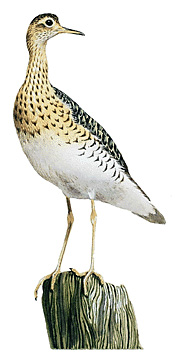Upland sandpiper is a North American bird that is usually found on wet prairies or meadows. It is sometimes called the upland plover.

The upland sandpiper reaches about 1 foot (30 centimeters) long and has an especially long tail for a sandpiper. Its color is blackish-brown and buff above, and buff with dark streaks on the breast and sides. Its belly is white. The bird breeds from Alaska to Montana and Maine. In fall, it migrates to southern Brazil and Argentina. There, the upland sandpiper winters on grassy plains known as the Pampas.
The upland sandpiper makes its nest in clumps of prairie grass or dry leaves on the prairie. The female lays four cream-colored or pale buff eggs, speckled with dark brown. The color of the birds blends with the grass, making them hard to see. The young birds can fly by midsummer, and they start south almost at once.
Upland sandpipers destroy many harmful insects, such as locusts and cutworms. The upland sandpiper is protected from hunters by law.
